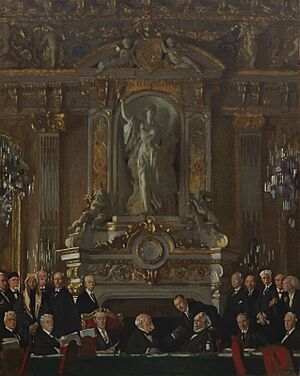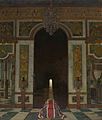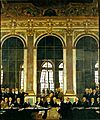A Peace Conference at the Quai d'Orsay facts for kids
A Peace Conference at the Quai d'Orsay is a painting by Irish artist William Orpen. He finished it in 1919. It's an oil-on-canvas painting. This artwork was one of several that Orpen was asked to create. They were meant to remember the important Paris Peace Conference of 1919. Today, you can see this painting at the Imperial War Museum in London.
The Story Behind the Painting
William Orpen was a special artist. The British government chose him in 1917 to be a war artist. This meant he would create art about the war. Orpen was also the official painter for the peace conference. He was asked to paint three large pictures. These paintings would show the important roles of politicians, diplomats, and military leaders at the conference.
This painting shows a group of people. They are having early talks for the "Council of Ten." This council included two representatives from Britain, France, the United States, Italy, and Japan. The people in the painting are sitting and standing around a table. They are in the Hall of Clocks. This room is inside the French Ministry of Foreign Affairs building in Paris. The conference officially started here on January 18, 1919.
The room itself is very grand. It has fancy chandeliers and a beautiful gold ceiling. There's also a statue of Victory above a decorated fireplace. These grand details make the politicians and diplomats seem small. The painting is about 124.4 centimeters tall and 101.9 centimeters wide.
Who Are the People in the Painting?
Many important people are shown in this painting. They are leaders from different countries.
Seated, from left to right, are:
- Vittorio Emanuele Orlando, who was the Prime Minister of Italy
- Robert Lansing, the US Secretary of State
- Woodrow Wilson, the President of the United States, holding some papers
- Georges Clemenceau, the Prime Minister of France
- David Lloyd George, the British Prime Minister
- Bonar Law, a British leader who later became Prime Minister
- Arthur Balfour, a British leader and former Prime Minister
Standing behind them, from left to right, are:
- Paul Hymans, the Foreign Minister from Belgium
- Eleftherios Venizelos, the Prime Minister of Greece
- Emir Feisal, a leader from Syria (who later became a King)
- William Massey, the Prime Minister of New Zealand
- General Jan Smuts, who was the Prime Minister of South Africa
- Colonel Edward M. House, standing behind President Wilson
- General Louis Botha, a former Prime Minister of South Africa
- Marquis Saionji Kinmochi, a former Prime Minister of Japan
- Billy Hughes, the Prime Minister of Australia
- Sir Robert Borden, the Prime Minister of Canada
- George Nicoll Barnes, a British politician representing workers
- Ignace Paderewski, the Foreign Minister from Poland
Other Paintings by Orpen
William Orpen created other paintings about the conference too. One shows the signing of the Versailles Peace Treaty. This happened in the famous Hall of Mirrors at the Palace of Versailles. Another painting shows a coffin covered by a Union Flag in a marble hall. This painting is called To the Unknown British Soldier in France.




